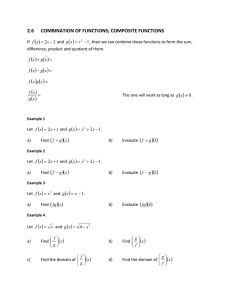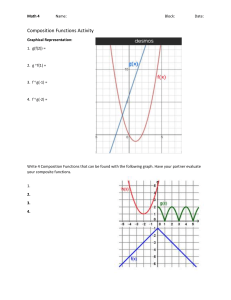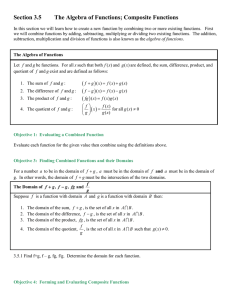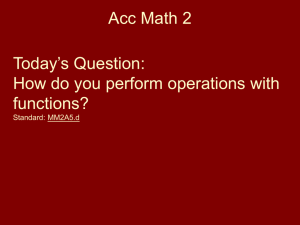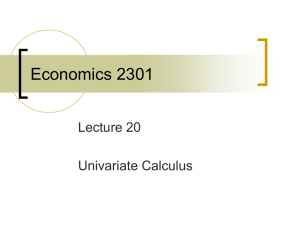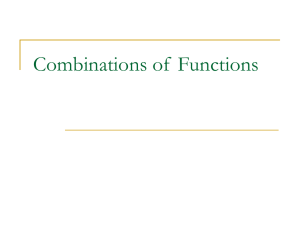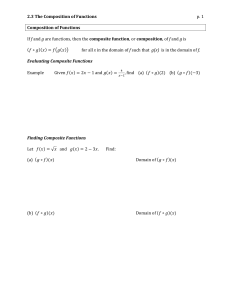g - Mathorama
advertisement
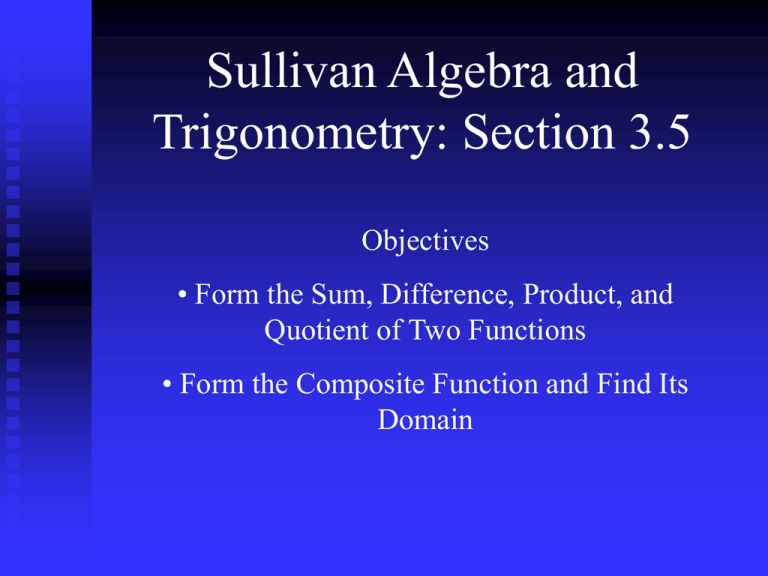
Sullivan Algebra and
Trigonometry: Section 3.5
Objectives
• Form the Sum, Difference, Product, and
Quotient of Two Functions
• Form the Composite Function and Find Its
Domain
If f and g are functions, their sum f + g is the
function given by
(f + g)(x) = f(x) + g(x).
The domain of f + g consists of the numbers x that
are in the domain of f and in the domain of g.
If f and g are functions, their difference f - g is
the function given by
(f - g)(x) = f(x) - g(x).
The domain of f - g consists of the numbers x that
are in the domain of f and in the domain of g.
Their product f g is the function given by
(f g)(x) = f(x) g(x)
The domain of f g consists of the numbers x that
are in the domain of f and in the domain of g.
Their quotient f / g is the function given by
(f / g)(x) = f(x) / g(x), g(x) 0
The domain of f / g consists of the numbers x for
which g(x) 0 that are in the domain of f and in
the domain of g.
Example: Define the functions f and g as follows:
f ( x) x 3
g ( x) x 2 16
Find each of the following and determine the
domain of the resulting function.
a.) (f + g)(x) = f(x) + g(x)
x 3 x 16
2
The domain of f consists of all real numbers x for
which x > 3; the domain of g consists of all real
numbers.
The domain of f + g is {x | x > 3}.
b.) (f + g)(x) = f(x) + g(x)
x 3 x 2 16
x 3 x 2 16
The domain of f - g is {x | x > 3}.
c.) ( f g )(x)= f(x)g(x)
x 3 x 2 16
The domain of f g is {x | x > 3}.
f ( x) x 3
g ( x ) x 16
2
f ( x)
d.) ( f / g )( x )
g( x)
x3
2
x 16
We must exclude x = - 4 and x = 4 from the
domain since g(x) = 0 when x = 4 or - 4.
The domain of f / g is {x | x > 3, x 4}.
Given two function f and g, the composite
function, denoted by f o g (read as “f
composed with g”) is defined by
f
g ( x) f g x
The domain of f o g is the set of all
numbers x in the domain of g such that
g(x) is in the domain of f.
Example: Given the functions f and g, find
(f o g)(2)
f
g 2 f g2
2
f 6
6 1
g ( x ) 3x
g ( 2) 6
35
f ( x) x 1
2
Example: Given the functions f and g, find the
domain of f o g.
1
g ( x)
x2
f ( x) x
The domain of f o g consists of those x in the
domain of g, thus, x = - 2 is not in the domain of
the composite function.
Furthermore, the domain of f requires that g ( x) 0
1
So:
0 x 2
x2
is {
The domain of f
g
x | x > -2}.
Example: Given the functions f and g, find f
1
g ( x)
x2
f ( x) x
f
g x f gx
1
f
x 2
1
x2
1
x2
o g.
